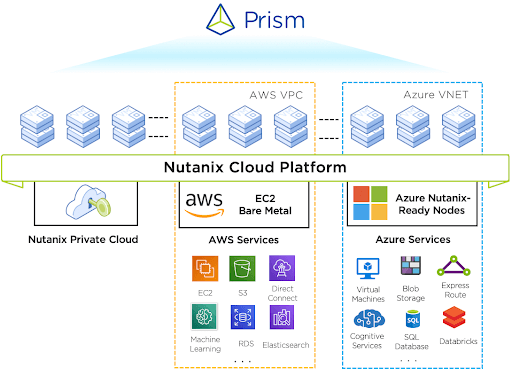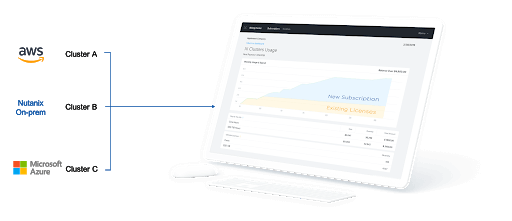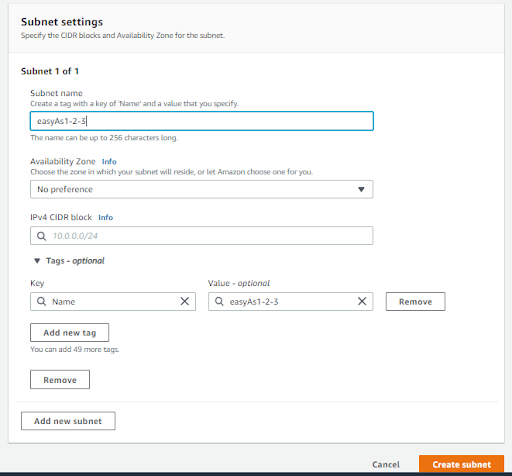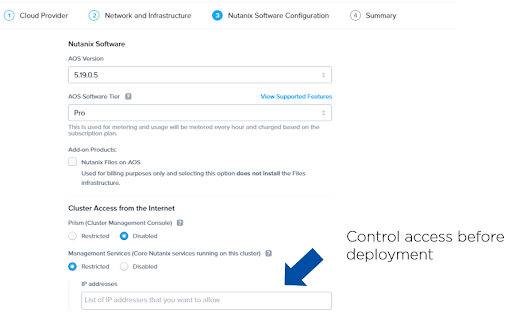Nutanix delivers a hybrid and multicloud platform called Nutanix Clusters, which helps businesses accelerate their cloud journey by delivering the best of both worlds - seamless private and public cloud operations. We believe Nutanix Clusters offers the best hybrid and multicloud solution in the market for customers looking to quickly deploy and integrate their existing on-premises datacenters with multiple public clouds.
If you want to move your on-prem applications to clouds such as AWS while maintaining the freedom to easily integrate multiple public clouds, Nutanix offers a solution that is quick to deploy, easy to manage, and keeps you in control of your infrastructure.
Check out what we consider the five unique advantages of Nutanix Clusters.

Fig 1: Nutanix Clusters makes it quick and easy to move workloads across public and private clouds
Note - the Nutanix Clusters solution is GA’d for AWS, and support for Azure is currently in development.
1. Self Service: No Need For Third Party Intervention
A big advantage of Nutanix Clusters is that it does not rely on a third party offering a hybrid cloud solution as a managed service, unlike several other solutions on the market today. The ability to deploy and configure your cluster, without any third party managing it, keeps you in control of the most critical infrastructure powering your applications and data.
The self-service nature of Nutanix Clusters allows for just-in-time deployment, which aligns well with most cloud consumption models. Regardless of cluster size, deployments times are about the same. Whether you're deploying a 3- or 16-node cluster, it can be operational in about 30 - 45 minutes. You can also migrate your apps to a supported public cloud without any refactoring at all.
As Nutanix develops support for additional cloud providers beyond AWS, such as Azure, you will be able to replicate your workload to a different cloud provider just as easily. You get complete flexibility and management control over both your on-prem and cloud infrastructure. Migrating your applications from on-prem to AWS, or across AWS and other public clouds, without any refactoring and while staying fully in control of your infrastructure makes Nutanix Clusters an ideal solution for today’s IT and cloud teams.
2. License Portability: Use Your Software Licenses Across Clouds
Nutanix Clusters provides Nutanix Software licensing flexibility across clouds, which is a big advantage over competitive solutions. If you’re moving your workload to AWS, you can utilize your Nutanix Capacity Based Licenses (CBL) on AWS to support the same capacity you are licensed for on-prem. For example, if you need to shut down your on-prem cluster, you do not have to buy more CBL licenses for the cluster being spun up in AWS; simply reuse your on-prem licenses on the public cloud. If you do not have any existing Nutanix CBL, you can purchase Nutanix software licenses for use only on public clouds, and those licenses will also be portable across public clouds. Once support is available for Azure, you will be able to move your Nutanix licenses across AWS and Azure.
If you are familiar with the Nutanix infrastructure management plane (called Prism Central), you will be able to easily use the same Prism Central instance to manage your infrastructure on-prem or on AWS. Cluster resource management can be integrated into Prism Element and only needs one Prism Central instance to manage multiple clusters. By doing this you are saving your resources for your workloads instead of using them for management tasks. In order to run Nutanix software on public clouds, you will need to purchase the Nutanix AOS software at either a Pro or an Ultimate license tier. You can read more about the features included in each license tier on our software licensing page.

Figure 2: License portability with Nutanix Clusters
3. Native Cloud Networking: No Need To Re-Engineer Your Network
Nutanix Clusters is a hybrid and multicloud solution that provides native AWS cloud IPs for your workloads that migrate from on-prem into AWS. This means that you do not need to deploy, manage, or consume the additional overhead of another network overlay on top of the one the cloud provider is already using. After you deploy your cluster, you can simply create a new subnet from the AWS console and add it to Prism, and then it’s ready to use with Nutanix Clusters.

Fig 3: Adding your new AWS subnet is easyAs1-2-3
Your workloads on Nutanix Clusters on AWS will have a fully routable cloud IP address that can talk to any existing AWS cloud services. If you want to access storage on S3, reach existing EC2 instances, or consume the latest cloud service, you don’t have to worry about it--it’s just going to work! Here is a short demo video that shows how to add the AWS subnet information in the Prism interface.
Not adding another networking overlay will also help you get great networking performance, as there are no additional managers and edge routers that will constrain your resources or become a bottleneck. Another benefit is that Nutanix does not dictate the networking design. For example, if you want to use Cisco ACI in the cloud or some other network service, you can do it out of the box. This native networking makes integrating third party services extremely easy, making Nutanix Clusters one of the fastest deployment models in the market.
4. Security: Built-in Security Groups Improve Data Protection
Nutanix Clusters is the only hybrid cloud solution that provides out-of-the-box integration with AWS security groups. When you deploy a Nutanix Cluster, AWS security groups are created by default to protect Nutanix Management VMs and the workloads that will run on the User VMs.
The built-in management security group contains all of the necessary ports to operate your Cluster. You do not have to redo this work by assembling a long spreadsheet and then pray that you did not miss anything. The security group gets applied to every management Elastic Network Interface (ENI) on the bare-metal EC2 instances. An ENI is a logical networking component that AWS uses to represent a virtual network card for the EC2 hosts. If you expand your cluster from 3 nodes to 16 nodes you do not have to worry about adding risk to your environment as security groups are automatically added to the new nodes.
The security group deployed for workloads is the same as the management security group deployed to every ENI used by the workloads running on your cluster. Without spending any additional money, time, or resources, inbound and outbound traffic is protected. If you need to get more granular protection, you can use your existing on-prem Prism Central for management and enable network and VM micro-segmentation. If microsegmentation is already running on-prem and you moved the workload, the microsegmentation policies will follow the application to the Cloud. Here is a short demo video that shows how Nutanix Clusters makes your life easier with these built-in AWS security groups.

Fig 4: Set the allowed IPs to the management services of the cluster before deployment
Another point to consider is that when an existing Cloud environment is already set up, you can deploy directly into it. This is important if you have spent the time and effort securing and providing connectivity from your on-prem datacenter to your cloud environment. This not only provides faster time-to-value by allowing you to run workloads more quickly, it also keeps your existing work to secure the cloud environment intact.
5. Hibernate - Deactivate And Reactivate Instances To Control Cloud Costs
The Hibernate feature of Nutanix Clusters (currently in tech preview) allows you to shut down your bare-metal EC2 instances running Nutanix AOS and move all of the Clusters storage to AWS S3 buckets. When you want workloads to return to where you left off, you can simply resume your cluster, and then storage is recovered from S3. This capability bridges the gap of fast cloud-native workload instantiation and traditional infrastructure management. In scenarios that only need compute to exist in spurts, like Dev-Test or seasonal workloads, but are still best served in traditional environments, the Hibernate feature provides the option of moving to a dynamic instance based model of public cloud, rather than static infrastructure on-prem. In addition to the cost savings from reducing infrastructure, this feature also optimizes operations and time, given that you can start and stop Cluster instances with just a few clicks. Here is a short demo video that shows how it works.
When Nutanix Clusters on AWS are being used for DR, if the RPO isn’t hourly, hibernate can be used to shut down the cluster in between replication jobs. Nutanix administrators can use the Cluster portal APIs to hibernate and restart from Prism Central using Playbooks or other orchestration and automation tools.
This distinctive Nutanix Clusters feature creates a new mode of operations in IT that weren’t available before: ephemeral infrastructure with data persistence.
You can see these benefits for yourself right now by taking a test drive of Nutanix Clusters. In a matter of minutes you’ll see just how easy it is to move workloads to public clouds like AWS. You can also start your free trial today.
Let Nutanix Clusters be your easy on-ramp to hybrid and multicloud architecture, the secure, flexible, and economical pathway to business innovation.
© 2021 Nutanix, Inc. All rights reserved. Nutanix, the Nutanix logo and all Nutanix product, feature and service names mentioned herein are registered trademarks or trademarks of Nutanix, Inc. in the United States and other countries. Other brand names mentioned herein are for identification purposes only and may be the trademarks of their respective holder(s). This post may contain links to external websites that are not part of Nutanix.com. Nutanix does not control these sites and disclaims all responsibility for the content or accuracy of any external site. Our decision to link to an external site should not be considered an endorsement of any content on such a site. This post may contain express and implied forward-looking statements, which are not historical facts and are instead based on our current expectations, estimates and beliefs. The accuracy of such statements involves risks and uncertainties and depends upon future events, including those that may be beyond our control, and actual results may differ materially and adversely from those anticipated or implied by such statements. Any forward-looking statements included herein speak only as of the date hereof and, except as required by law, we assume no obligation to update or otherwise revise any of such forward-looking statements to reflect subsequent events or circumstances.